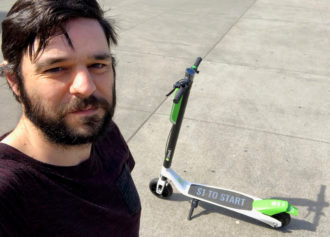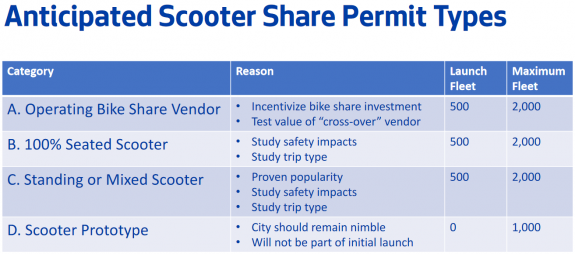Scooter share permit gets committee approval + How the system would work

Yours truly took a test ride of a Lime scooter in 2018. So this has been a long time coming.
Seattle is finally maybe going to give shared scooters a try.
The City Council Utilities and Transportation Committee voted last week to approve two ordinances that would allow SDOT to launch a scooter permit program (Council bills 119867 and 119868). Councilmembers Strauss, Gonzalez and Morales voted in favor, Pederson opposed. The ordinances still need to pass the full Council during the September 8 meeting.
We've been having this academic conversation about the use of scooters for 18 months or longer," Councilmember Dan Strauss, the legislation sponsor, said during the committee meeting. I still have many concerns that need to be addressed, but we are at a point where the academic conversation has gone on long enough that if we don't try this in the real world to see if this program does work and is appropriate for our city, we're just going to keep circling around the same questions."
And some of those questions are not entirely answered by the permit plan or by the Council actions, which would allow SDOT to enact their permit fee structure and would make some changes to city code regarding scooter use like allowing people to ride electric scooters in bike lane, on trails and on some stretches of sidewalk that are part of a bike route (like the Fremont Bridge for example). Oddly, this was not already the law, though people already use scooters this way. These law changes affect all electric scooter users, whether they are riding a personal scooter or a shared one.
If we are able to allow people to learn to ride these scooters in good weather while it's not rainy and dark, we have a higher likelihood of people being able to use these in a responsible and effective manor," said Strauss.
Most the scooter rules will be similar to bike share rules, though scooters are currently illegal on sidewalks and the city is not looking to change that. Like the bikes, they will be limited to top speeds of 15 mph and must be parked in the furniture zone or an on-street bike corral.
But because research has shown that a large percentage of solo injuries happen on a person's first scooter ride, they are taking some rather extraordinary steps to make the first ride safer. For one, a user's scooter will also be limited to 8 mph during their first trip. That way they can get used to how to handle and stop it at a slower speed.
We saw in a lot of studies done that injuries are happening in the first few rides, so we're saying, Hey, for the first few rides, you need to go slower. It might not be as convenient, it might not be as fun, but it's going to be safer,'" said Joel Miller at SDOT during the committee meeting. The city has the authority to expand the 8 mph limit to more rides, but they also don't want to make the mode so slow that people don't choose to use it.
Users will also need to complete a quiz showing they know the rules about riding and parking.
We need the vendors to develop quizzes that people need to interact with and need to answer correctly within their first few rides and every several months thereafter showing that they understand how to park correctly and how to ride correctly," said Miller.
The city can also require companies to geofence areas where they don't want scooters to be parked.
[Geofencing] technology has come a long way in the past year and is starting to get more and more accurate," said Miller. Say, in front of Pike Place Market, if it's inappropriate for a scooter to park there and ride there, we can tell vendors to geofence that area."
Seattle is also requiring scooters to have two brakes rather than the one brake common on many scooter models. Hopefully this helps with concerns that scooter riders won't be able to safely handle Seattle's very steep hills.
Ten percent of fleet needs to be in designated Environmental Justice Community Areas," which make up about 10% of the city's land area. And if a user qualifies for SNAP benefits, ORCA Lift or another social program, they must be offered a discounted rate at or below the ORCA Lift rate of $1.50 for a ride. SDOT will also use a portion of the fees to educate people on their low-income access options.
Vendors will pay $150 per scooter from vendors, and they are willing to pay that," according to Miller. These fees fully fund the program and bring new revenue to the city to build bike and scooter parking. Since bike share has declined, so has the attached funding for bike parking. SDOT will also be using bike share fees to continue the city's partnership with Outdoors for All for increasing access to adaptive cycles.
 The caps for scooters and bikes are separate, so a company offering both modes would not be put in a position of choosing between bikes and scooters. This is good news for bike share since scooters are likely to be more profitable than bikes. Maybe a company that's already offering scooters would find that it makes sense to also offer bikes since they already have staff and so much other necessary infrastructure in place.
The caps for scooters and bikes are separate, so a company offering both modes would not be put in a position of choosing between bikes and scooters. This is good news for bike share since scooters are likely to be more profitable than bikes. Maybe a company that's already offering scooters would find that it makes sense to also offer bikes since they already have staff and so much other necessary infrastructure in place.
The city is also carving out permit space for a seated style of scooter and for an unknown future prototype, an acknowledgement that they don't know what will come next and want to be prepared for whatever it is.
We know this is an ever-shifting industry, and we will need to stay nimble and adapt," said SDOT Director Sam Zimbabwe during the meeting. We can't depend alone on bike share for the millions of annual trips it provided without better understanding what those market conditions are and where and how we will need to evolve and iterate on those programs over all. And we think that this program is the best way to build on our success with bike share and give people of Seattle clean healthy and safe transportation options."
Scooters do have potential to help people get around during COVID and during the West Seattle Bridge closure. In many cities with scooters, including Portland, Detroit and Baltimore, scooters trips are now longer and more likely to be used for essential trips, SDOT said in the presentation. And with a very ambitious goal of shifting West Seattle trips by transit and water taxi from 18% before the outbreak to 40% during the bridge closure, scooters could be one way to help more people access these transit services. Scooters obviously won't solve the problem, but they can be part of it.